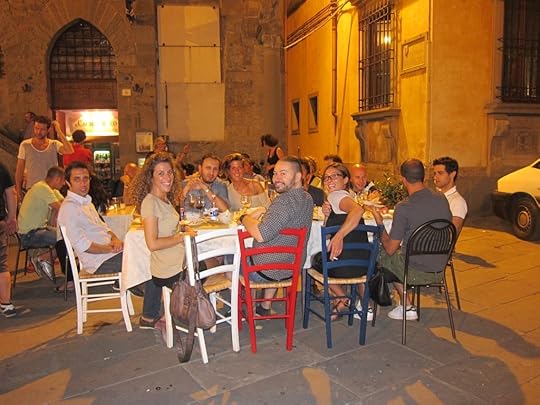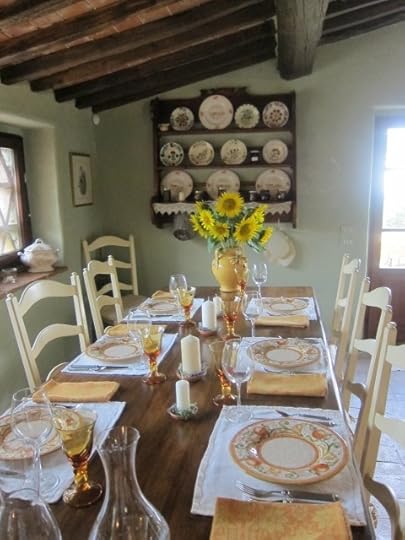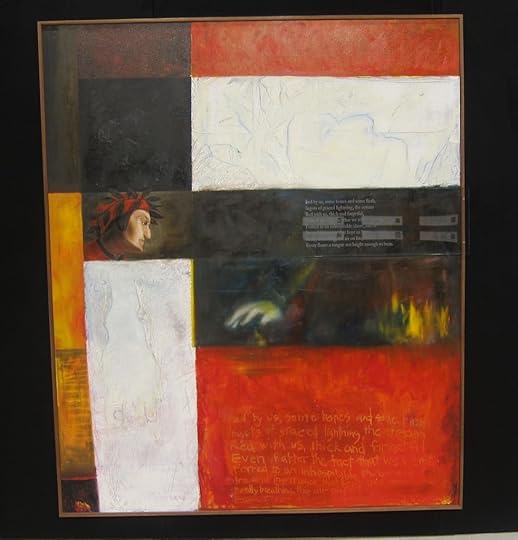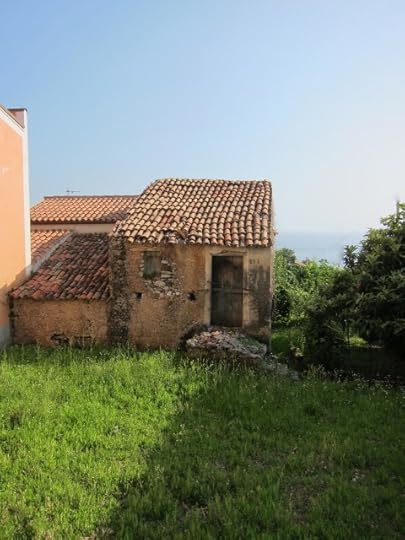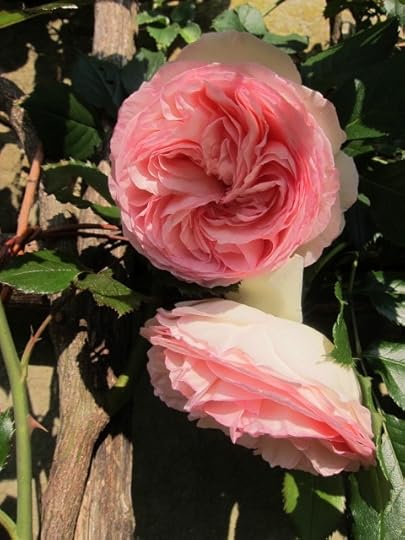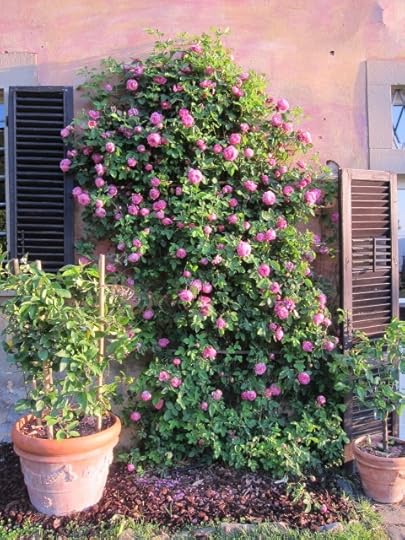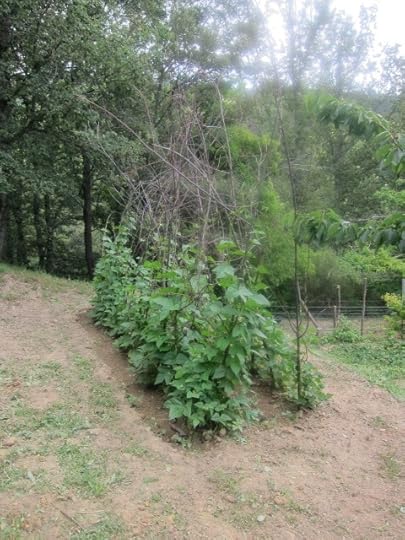Frances Mayes's Blog, page 9
September 26, 2011
Tuscan Sun Agenda for 2012
Not really a commercial moment, just wanting the share my good luck of having an agenda published every year by Chronicle Books. The pleasure is that I get to work with Steven Rothfeld. He is also the photographer of BRINGING TUSCANY HOME and of the cookbook coming in March. Travel is his passion and he has the best eye for landscape, detail, and sense of place. As much as he travels, he retains a fresh sense of adventure.
I still love to keep a written agenda rather than tend to my computer's efficient calendar. In it I note books I've read, restaurants, ambitions, new words–it's a very personal notebook, complemented by photographs, recipes, quotes. Here's a look at the cover and inside.
[image error]
The mysterious Bramasole rose makes an appearance:
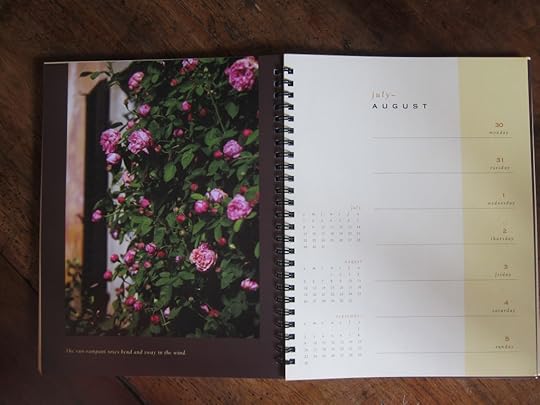
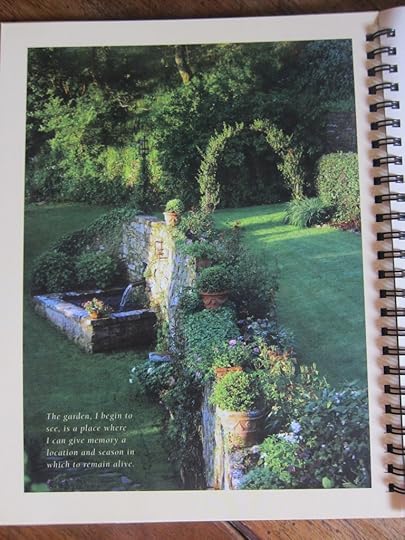
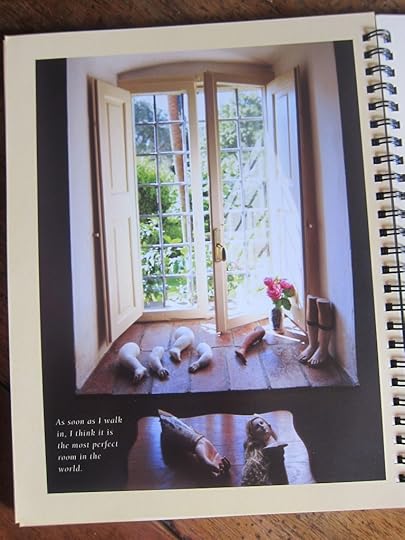
Hard to stop! There are so many evocative images. Grazie, Stefano!
September 21, 2011
Colors of Summer
In Cortona, half way into September, summer still reigns. The lack of rain has turned the fields the color of lion's fur but the geraniums love the intense sun and are blooming their hearts out. Looking through my notes and photos from the greener part of summer, I wanted to get out my watercolors and dash off some of my awful interpretations of color and collision of shapes. (Those I always will spare you!) Better to share some notes and photos instead. What you can't see well in this photo taken at Bramasole is all the butterflies in the lavender–they set the scene in motion, while the old mother cypress loomed over all.
[image error]
Corn (for pigs), sunflowers, Cortona. Our house is on the slope to the right, from the top of the hill. Someone, not I, could paint this but even the photo is pretty nice. I like the clouds and the shadows of clouds and the gentle profile of our ancient little city along the hill.
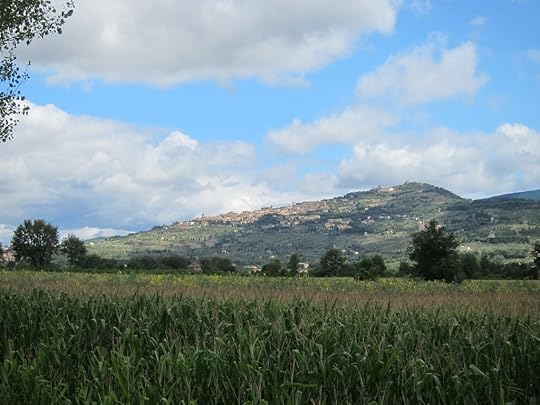
Our garden is still rife with peppers, eggplants, tomatoes and tender little lettuces. I wonder if Georgia O'Keeffe ever painted a zucchini flower.
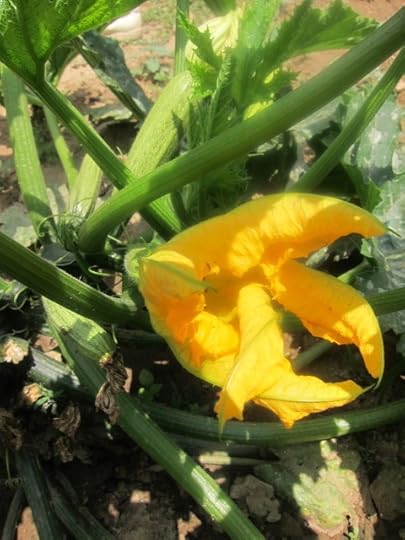
OR ever ate them fried! I could eat these colors:
[image error]
Sunflowers are gone now, except for a few stragglers in the fields. We plant a long upper terrace of them every summer, just to see their smiling faces nodding down at us every day, or to gather an armful for the table. In the shot below, those are Vietri plates, flatware, and glasses. The owners of Vietri–headquarters is located in Hillsborough NC–gave us several sets to use for photographs for The Tuscan Sun Cookbook, coming out in March, 2012. The colorful bowl on the plate rack came from a local antique store–they were about two dollars each and have a spontaneous and rustic charm. The table is from my At Home in Tuscany collection with Drexel Heritage and the chairs we had made in Citta di Castello. One of the joys of Italy–you can draw a design, take it to an artisan, and he will look at it and say, "Twelve chairs like this? Would two weeks be okay?" The candles are in terracotta flowerpot saucers, and are surrounded by herbs–simple!
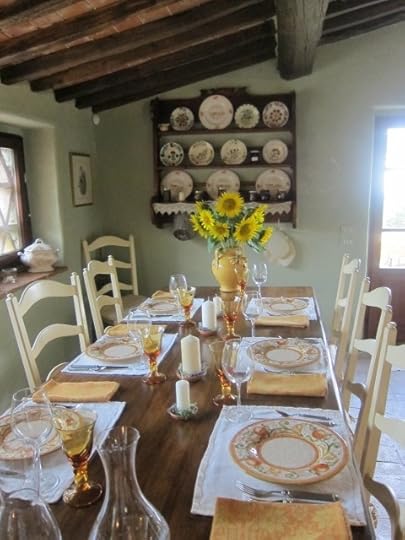
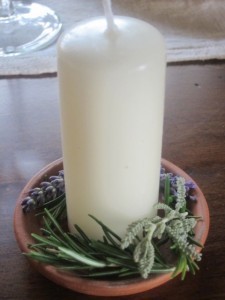
Ah, here, in this shot taken at Fonte delle Foglie, our mountain house, you can see the butterflies! Not the bumble bees, who mine the lavender all day. We brush past them but they are not the least interested in us. The lavender took over the path, happily so.
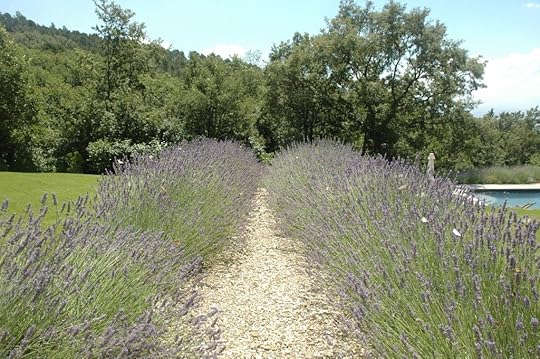
Summer now is an illusion. Days are shortening, nights are cool, and yesterday we had one of those storms that, around here, they claim "breaks the back" of summer–Zeus flinging bolts around the skies, drenching rain, wind strewing a covering of pine needles over the grass. Time to pull the duffles from under the bed and find some sweaters.
August 8, 2011
Moving into August
Italy grinds to a halt in August. If you've not had that leak repaired in July, it won't be repaired until September. Everyone is al mare, at the sea, up north in the Dolomites, or visiting relatives back in the old home town. Festa is the word. Here in Cortona, we have the Sagra della Bistecca (grilled steak feast) followed by a porcini feast in the park, with the largest frying pan on earth sizzling with porcini. And, of course, we have The Tuscan Sun Festival, now in it's ninth year. www.tuscansunfestival.com
Since everyone is on vacation, parties are on the collective mind. The piazza is hopping.
This is the month we make up the most beds for guests, the month when going to bed at two is the norm, the month our tables are the most laden. Here's our mountain house kitchen table, ready for guests. That's Vietri dinnerware. www.vietri.com Two friends of ours own the company and they gave us several sets for the food shots in our Tuscan Sun Cookbook (coming out in March). The candles are sitting in flower pot saucers, with a few herbs around them, and the sunflowers are from our garden.
Every bite on the table, except the meat, is from our garden. What a pleasure! The faraona, guinea hen, in the middle, was roasted in our outdoor bread oven, along with the potatoes. This dinner was preceded by prosecco outside, along with a stupendous amount of fried zucchini flowers and onions.
They are as good as they look. We make a batter of beer and flour, dip in the vegetables and fry them in peanut oil. Everyone always eats two or three more than they think they should. Here they are served on a cross-cut of a fallen log–very rustic and handy for serving.
The Tuscan Sun Festival includes this year "From Things about To Disappear, I Turn Away in Time," an art show by Ed, my husband, and our great friend Alberto Alfonso. The mayor cut the ribbon and we walked into the spacious Chiesa di Sant' Agostino to see the result of the long collaboration between Ed and Alberto. They've been exchanging work–Ed, poems, Alberto paintings–for a year and a half. The goal was poem-a-day, painting-a-day, but of course life intervenes. Still, through this call-and-response exchange, they have accomplished an astonishing amount of work. The exhibit is in a huge deconsecrated church, allowing lavish display space. The show's title is a quote from Samuel Beckett. All three of us have been haunted by the ambiguity of "in time." I am the bystander in this collaboration but have found good inspiration for my own writing and thinking.
The Festival's music program was superb this year. The concerts are at nine and there are dinners afterwards, hence all the late nights. This is a great time to visit Cortona. Check out the program. There are lectures, wine seminars, tango lessons, yoga classes, cooking classes–a great summer camp for grown-ups who want stimulating cultural activity. Jeremy Irons performed with musicians in our intimate Teatro Signorelli, taking time out from filming The Borgias in Budapest. He played Chopin, and his wife, Sinead Cusack, played George Sand.
Thanks for the good wishes about our garden destroyed by hail. It's coming back and if you didn't know what it usually looks like, you'd think it was fine! Hope all of you reading this are enjoying red, red tomatoes, cold watermelon, and peaches-and-cream corn! (Except south of the equator, where I hope you're enjoying all the pleasures of the cooler seasons.)
July 19, 2011
Maratea in Basilicata
Cortona was hit by an intense hailstorm. Looking out the window, it was easy to imagine that the gods were enjoying an ice ball fight. With the lashing wind, the hail whizzed by sideways, straight up, down, and on the diagonal. I stepped back from the window when one hunk the size of a golf ball broke through the old glass. In half an hour, calm descended, the grass was covered in ice and our garden was destroyed. It looks innocent enough:
All the gaily tumbling geraniums, cut to the nub. The lemon leaves shredded. The roses torn to nothing. Wind brought down limbs and practically stripped the pine needles from the trees. The trailing surfinias, masses of blossoms moments earlier, were simply gone–just a pile of broken petals. Two more of our wavy glass windows broke. All over town, the same story. We could no longer complain when we heard that many lost their crops. And we were reminded of all the really terrible tornadoes, hurricanes, earthquakes that terrorize people all the time now. Fabio and Carlo appeared the next morning to survey the damage and start the clean up. Fabio seemed close to tears–all his work wiped out in half and hour. We all worked for two days and Bramasole is clean again, if bleak. I replanted a few pots from the diminished nursery stock but, still, we will have a green but sparsely flowered summer. I can barely look at the hydrangea hedge.
We had been planning a brief trip so once order was restored, we took the fast train to Rome, changed there for another fast train–there are many new ones and I love to travel by train with my bag of sandwiches and water, a good book, and all of Italy flashing by the windows. We changed trains again at Sapri, onto a dinky little train with bright blue seats, yellow walls and blue ceiling, which whistled and swayed all the way–15 minutes–to Maratea. There we met four friends, two Italian women and their English and Australian husbands, at the lovely art nouveau villa Hotel Cheta Elite.
Basilicata is dramatic. The mountains run into the sea, creating secret coves and the kinds of beaches you dream of when you imagine the Mediterranean. From our airy, large room:
You can't see the crescent of pebble beach or how clear, clear the water is. We took our snorkling gear but didn't use it because you could see all the way to the bottom anyway. The water was fresh according to Ed and cold according to me but we swam for hours, floating and somersaulting and really swimming, as you can when there's not much surf. All around the hotel were strenuous hikes. We assed many houses abandoned around the tiny town of Acquafredda near the hotel. Here's one awaiting your cosmetic touch. I think it needs a white goat, too.
The town of Maratea, about six miles away, has as much charm as a Tuscan hill town, plus views of the sea. In the churches, I liked so much the exuberant use of tile.
That blue must always remind the worshipers of the sea. Such a dramatic setting offers the possibilities of hiking to villages that make the best ricotta, mozzarella, and bread. One local specialty is cedro marmalade, made from those gigantic lemons you see in the south of Italy. The food of the area is lusty and intensely flavorful. One of the best pastas ever was served at our hotel–paccheri with eggplant, peppers, zucchini, tomato, onion, garlic and topped with the grated mozzarella and the creamiest ricotta I've ever seen. It had the texture of whipped cream. I've made it since I returned and mine was good but I was reminded of just why food that is truly OF a place is so hard to duplicate. I'm not going to find that exact ricotta anywhere but there. So, the elusive ingredient becomes a part of memory.
It's fun to meet friends in a new place and explore together. A new level is added to the friendship that way. You step out of your usual patterns together and see the new through your own eyes and theirs. I love short trips; they imprint themselves indelibly because your focus is tight. I'm going to hold that pleasure of the sea in mind all summer.
June 30, 2011
Con Questo Caldo
These days, when you say "How are you?" to someone in Cortona, the answer is usually, "Con questo caldo. . ." and a big shrug. In other words, "With this heat, what is there to say?" With the heat appeared the cicadas with their double-time racket in the pine trees. Their yammering accents the beating down heat. Oh well, under the Tuscan sun. What can I expect? With the heat also comes the great vegetable season. Our orto is beginning to give forth cucumbers, lots of lettuces, potatoes, and green beans. One tomato has ripened but the laden bamboo trellis promises a big crop in a couple of weeks.
Meanwhile, the roses continue to have their day. Along our upper terrace and our "Polish" wall are Pierre de Ronsard, called Eden in the U.S.
Here's Pierre up close:
It's my favorite, aside from the unidentifiable one we call Bramasole rose. Two of them survived the thirty or so years the house was abandoned and have continued to flourish for the twenty-one years we've owned the house. It has the most ethereal and deeply sweet fragrance of any rose I've ever met. Despite many trips to rose nurseries and consultations with gardeners, I've never come up with an identification. Here it is–a tight peony-like bud and a many petaled bloom when open. That color!
Against the house, it's a climber and when in bloom we can smell the fragrance in the dining room and at the little outdoor table where we have dinner.
My other favorite is the rose named for Rita Levi di Montalcino, an Italian scientist who won the Nobel a few years back. She's a plucky bloomer and a transcendent beauty:
After all these flashy blooms, you have to look closely in the orto to appreciate the lovely little purple eggplant flowers and the delicate yellow cucumber and the tiny white potato blooms. The orto has much interest for the eye, however. I love the inventive and natural constructs for supporting plants as they develop. Here, beans climb branches cut from the woods and stuck in the ground:
And below, here's the whole orto, with the bamboo teepees for the tomatoes, and more branches in the ground for the cucumbers. At the far end, just out of sight are the strawberries and raspberries, both red and the even more delectable yellow. The basket is full of the first, just dug, potatoes. Simply boiled in big chunks then seasoned and given a few splashes of olive oil and some chopped parsley–nothing better!
To take that basket down late in the day and pick most of dinner is such a profound joy! We are loving simple vegetable pastas at night. I sauté, separately, zucchini, tomatoes, onions (with some garlic), peppers, and eggplant, all in great olive oil, season each and then mix them together in a skillet for a few minutes, just for them to become acquainted with each other, then mix in penne or farfalle or any pasta on hand with a handful of parmigiano.
Summer food! Kiss the ground!
June 14, 2011
Divino Tuscany
Wine comes in at the mouth
And love comes in at the eye
And that is all we shall know for truth
Before we grow old and die. . .
Those line from William Butler Yeats never seemed as true as they did last weekend, when Ed and I, with our friend Alberto, attended the grand wine event, Divino Tuscany, in Florence. Organized by James Suckling, former Senior Editor and Eurpoean Bureau Chief for The Wine Spectator, and by Barrett Wissman's IMG Artists, the three day extravaganza celebrated top Tuscan vineyards and brought a group of 300 wine collectors together for feasts and conversation and considerable tippling. James Suckling:
The opening night dinner in the garden of the Four Seasons Hoter was prepared by chef Vito Mollica, with a concert by violinist Joshua Bell preceding the dinner. He is a frequent performer at The Tuscan Sun Festival (www.thetuscansunfestival.com) and is always a pleasure to hear. This venerable property must be the most beautiful of the Four Season group of hotels. The extensive garden is bookended by two buildings where the tastings were held. The above photo was not taken in the garden. You'll be surprised to read later where this was shot! The mornings were devoted to tutored tastings (newer vintages, mature vintages, brunello, merlot) and the afternoons to meeting the winemakers, each of whom had a table, and, of course, to tasting innumerable fine wines. James invited the top fifty winemakers in Tuscany to participate. We met some makers of our favorite wines, such as Giancarlo Pacenti, Lamberto Frescobaldi and Giacomo Neri, and were introduced to many new ones. Two of our favorites, our friends Antonio Moretti (Sette Ponte) and Riccardo and Silvia Barrachi (Baracchi) were pouring their great wines. Such an event requires pacing and stamina! The pros were spitting; we just sipped and moved on.
Dinner the second night was a stellar event at Palazzo Corsini (www.palazzocorsini.it). It was catered by Annie Feolde of Enoteca Pinchiorri, the most starred restaurant in Florence. The vast palazzo has glorious frescoed ceilings and all the stucco and pomp that could be pumped into it in late baroque Florence. The chandeliers were the size of Fiats. Everyone wore summer evening wear and the tables were graced with enormous armfuls of flowers. At each of the tables, a winemaker presided and poured his own wines. We enjoyed the company of Marcello Lunelli of Ferrari, whose spumante we often pour for guests. After dinner, soprano Isabel Suckling (www.thechoirgirlisabel.co.uk), James's thirteen-year-old daughter, filled the courtyard with her pure voice.
On Saturday, a few people were invited to have lunch with Ed, Alberto and me at JK Place, a small hotel near Santa Maria Novella. It was a good pause and a chance to make new friends. The hotel seems intimate–you feel you're visiting a glamorous friend's place. I'd like to check in when I have a deadline and just kind of hole-up there for a few days, venturing out only to see the Ghirlandaio frescos across the way, which we did after lunch. We also stopped in at the old Santa Maria Novella pharmacy. I wanted to buy Alberto some of their famous potpourri, which is far, far from the normal house ambience scents. Alberto rewarded me by saying that it "smells like time." Ed more bluntly said it smelled like "the Doge's old socks."
We were up early, walking along the River, stopping for coffee at Rivoire and for a second one at Giacosa. Ed and Alberto:
We peered into a few gorgeous shops but didn't buy a thing except some beautiful paper at Parione on the street of the same name.
Saturday night's treat was amazing. The winemaker's hosted groups of thirty at their villas in the country, or at their palazzi in Florence. This was such a lovely gesture–all of us had the chance to dine in their homes with their families and to glimpse the rarified world most of these winemakers inhabit. Buses took groups to their assigned places but ours was just a brief walk across the Arno to the vast Frescobaldi palazzo, where several family members have large apartments. It was fun to meet the 30th generation of winemakers from that family and they warmly welcomed us. Their palazzo's garden is bordered by the back of Santo Spirito, and by family rights from when Brunelleschi built the church, a little inside hallway connects to a secret room which overlooks the interior of the church–a private spot to hear mass. The bell tower of the church is actually in the garden. The palazzo is filled with a dizzying number of paintings. I imagine forgotten rooms with armadios full of nineteenth century dresses and chests crammed with letters and archives in spindly writing.
We were ready to stay up late so we walked over to Gallery Hotel Art, one of our favorite place to stop for a drink. Alberto, an architect, admired the room housing the bar, a perfectly plain glass rectangle jutting out into a back street. The waiter brought over a big plate of sushi, of all things. Ed and Alberto got into the Averna, while I had something lovely and nonalcoholic (at that point!) called a Fred. Walking back to the Excelsior, I was sorry I had on high heels.
The last event was a lunch at the country villa of Trudi Styler and Sting. Alberto, born in Havana, was particularly thrilled because the Cuban group, Tiempo Libre, played all afternoon. Trudi and Sting operate their estate as a biologico, organic farm and sell their own honey, wine, and olive oil. The garden in the background of the James Suckling photo was at their home. Several roasted pigs, salads, potatoes, breads, and vegetables were spread along many tables and the wine poured freely. Here are a few shots.
The approach to Sting and Trudi's Il Palagio:
At the Pig Roast:
Sting and Trudi Styler:
What was very special was the level of hospitable detail. Our hosts spread purple blankets and cushions on the lawn for lounging and listening to the music. Each table was set with herbs and sunflowers. There was not a paper cup in sight. A dreamy afternoon in the country. I loved their garden, the renaissance formality paired with country flowers. At four, we pulled ourselves away and drove home to Cortona. Divino Tuscany will take place again next year. Anyone passionately interested in wine or anyone wanting to learn about Tuscan wine or anyone just flat-out hedonistic will have a fantastic and memorable weekend.
June 12, 2011
Patrick Leigh Fermor
I almost met Patrick Leigh Fermor a few years ago when I was in Mani for the baptism of a friend's boy. He was to have been there, too, but had to cancel. What a privilege that would have been. He was a grand writer who so loved this world. I have admired and relished his books, all of them, but maybe especially Mani. He got to live a long, long life and seems to have been totally alive to every moment of it. http://www.nytimes.com/2011/06/11/books/patrick-leigh-fermor-travel-writer-dies-at-96.html?hpw
May 30, 2011
Bramasole Olive Oil
We had a very nice mention by Charlotte Druckman in Saturday's Wall Street Journal.
http://online.wsj.com/article/SB10001424052748704904604576335233225766412.html?KEYWORDS=charlotte+druckman
May 24, 2011
Bramasole Pleasures
Arriving at Bramasole, our house in Cortona, always brings a rush to the senses. In late May, the ginestra, wild yellow broom, sweeps across the hills like a brushfire. The whole slope below our mountain house is aflame and we roll down the window as we drive for the golden scent. This is the time that the cuckoo is heard in the land. It really does say "Cuckoo, cuckoo," and if you answer, it will keep on the conversation forever. One day in June they'll be gone. That's the essence of Tuscan spring, really–an ephemeral collection of pleasures. Fave are one. The day we arrived, Albano came over with a basketful, picked that morning in his garden.
A favorite pasta is simply pici with fresh fave, little cherry tomatoes, great olive oil, and grated pecorino. In Tuscany, the fava is revered at this time of year, especially when it's served as a snack or antipasto with some very fresh percorino–also of the moment. We were lucky that the same day Albano brought the fave, Lapo stopped by with a gift of twenty-day-old pecorino.
Lapo and his family are neighbors who have a very personal agritourismo, Casale della Torre. www.casaledellatorre.com We send friends there for the experience of living with a friendly and authentic Tuscan family. Lapo is also a shepherd who makes cheese regularly. His guests often get to participate, as do Ed and I. Usually the cheese-making ends with some WWII-era records playing on an old phonograph and Lapo swirling me around the cantina with the ancient smells of rennet and sheep milk. The cheese is creamy soft and mild, and with the raw fave, a deeply indigenous pairing of tastes.
We are here in time for the last of the local asparagus. It, too, will disappear for a year. To anticipate that absence, we are roasting a full pan every night. We just lay it on parchment, drizzle with our oil, add salt and then run it in a hot oven for 5-7 minutes, depending on how thick it is. We both prefer the local kind–fat and crisp.
I was happy to use the colander shown in the photo. I love old kitchen equipment and found two 30's or 40's aluminum colanders at the monthly Arezzo antique market last summer. I've missed using them. Often old cookware is superior (sometimes not). This colander has feet and very small holes, which means you can wash things like farro and lentils without them slurping through. Meant to last, the handles are sturdy and the colander is BIG.
The other one I bought is lighter and has a handy hook on the side so it can go inside a pot. Look at the graspable handle and the nice form!
The Arezzo market is the first weekend of the month. I like to look for vintage aluminum espresso pots and the neat two-tiered pails workers used to take their lunches in–as well as my usual naive religious artifacts and paintings. The colanders are the best I've ever used. A simple joy in the kitchen–and there are many other such joys that take one back to a connected and rational way of life: living in the season, using the powers of nature. Another small pleasure–every house has a stendino, a folding rack for drying clothes. On returning here, I forget the dryer and choose that endlessly renewable source, the sun. I like hanging out clothes and later gathering them, warmed and rather stiff. In full sun, they dry as fast as in the dryer and smell like spring.
Ecco Maggio! That's an old song–Here's May.
May 20, 2011
Arriverderci to North Carolina Spring
We have migrated to Italy and a minor surgery on my finger–right hand!–kept me from the computer the last days before I left. I spent a lot of time in the garden and had a little time just to soak in the beauty of a southern spring. Of course, spring is beautiful everywhere and now that I'm in Italy, I'm dazzled all over again (meadows of poppies!) and also filled with that sense of renewal the season brings.
Our farmhouse in North Carolina has a garden of old roses planted in the 1950's and onward. Many of the plants are on their downward spiral but we are giving them care while we replant as we can. My grandson and I took on the project of rewriting the labels on all the old bourbon, noisette, grandifloras, and musks. He was delighted with the names and with a Sharpie, retraced the letters that someone else had labeled. When the labels were gone, we redid what I knew and sadly left the rest unnamed. I hope to identify all of those with the help of rosarians. The tracing over someone's writing was a little eerie but also satisfying because some were faint and we remarked that if we'd not written over the letters that day, they might have been lost. The highlight of the project was that Willie got to spray clear sealer over the labels. This is a part of the three-room rose garden now in my charge:
The pump house in the rose garden is covered with a rose called Gardenia:
Gardens seem like a place for memory and at the same time they are fragile. A summer of neglect and chaos descends. Acquiring an old garden, though, seems to give me links to the woman who first designed it. I can look at her beds and borders and hear her thinking. Clearly, she was a dreamer. And ambitious. And she must have had a lot of help. She liked garden rooms; I like views. A later owner planted some evergreens that look ugly to me but I haven't removed them. Another owner put in a water feature my grandson calls Brief Creek. What a nuisance–leaves clog the pump, mosquitoes breed, and the thing has to be laboriously cleaned frequently. Still, the sound is nice and the plants have filled in enough to make it look totally natural. We'll leave it. Meanwhile, I've cut down on the many flower borders–just too much to maintain–and have planted a lot of fruit trees. Everyone who passes through leaves their prints. I wonder who planted all the peonies, my favorite. Here are a few of them.
To open the view, I've lowered hedges. Now we can see the lower garden from the house.
There's one of those evergreens on the left that bother my eye. But it contributes its shade of green to all the other shades that make up spring.
Now I'll be writing from Italy. I'm happy that my daughter and her family will enjoy the garden in North Carolina. (Please weed the vegetable garden!)

